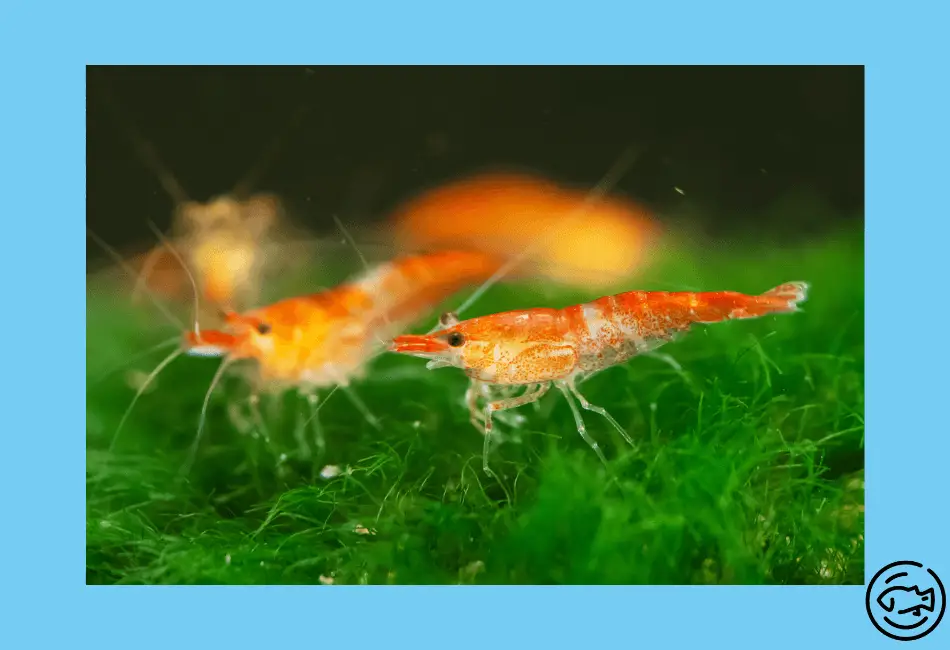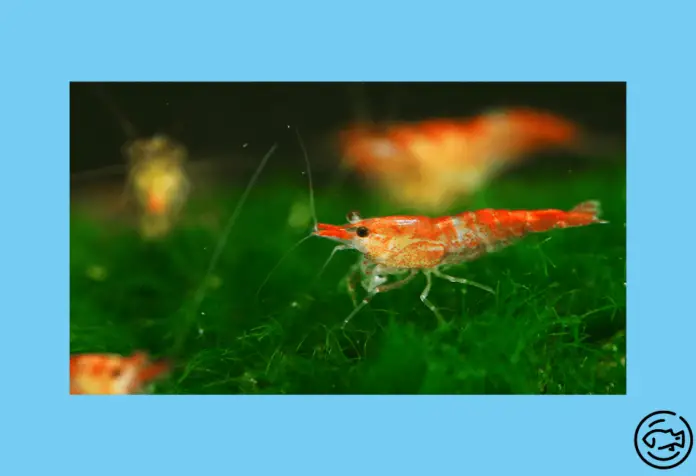Throughout this article, we’ll explore the captivating realm of freshwater shrimp, explicitly focusing on the Neocaridina shrimp.
This collection of dwarf shrimp encompasses species like Snowball Shrimp, Blue Pearl Shrimp, Cherry Shrimp, and Yellow Shrimp.
Read on to discover more about these intriguing Neocaridina shrimp species.
Overview
Neocaridina shrimp are small, vibrant crustaceans that come in an extensive array of colors. While their natural hue is a blend of green and brown, they can now be discovered in shades such as orange, green, red, yellow, blue, violet, and black. This diverse color palette makes them a stunning addition to any aquarium.
The Cherry shrimp is the most manageable variety for novice enthusiasts, as other breeds can be more challenging to care for. These captivating creatures originate from Southeast Asia and are typically discovered in ponds and streams.
Their natural habitats include rocks, plants, and wood as substrates.
A selection of Neocaridina species that would make excellent additions to your aquatic display includes the Blue Velvet Shrimp, Sky Blue Shrimp, Snowball Neocaridina, Bloody Mary Shrimp, Fire Red Cherry Shrimp, Blue Dream Shrimp, Orange Shrimp, Yellow Shrimp, Yellow Golden Back Shrimp, and Sakura Red Cherry Shrimp.
This extensive guide will deliver all the essential information about Neocaridina shrimp. In conclusion, we will address frequently asked questions and provide concise explanations.
Appearance Neocaridina Shrimp

Neocaridina shrimp are diminutive and possess an elongated bodies. They feature five pairs of ambulatory appendages known as Pereopods.
The initial two pairs of legs have evolved into chelate structures resembling claws that enable the shrimp to grasp their food.
In front of the pereopods, the remaining pairs of maxillipeds function as jaw legs, assisting the Neocaridina in feeding.
Beneath the shrimp’s abdomen, five pairs of limbs called Pleopods can be found, which are used for swimming. Additionally, these appendages serve to hold eggs in female shrimp.
As for the shrimp’s rostrum, it is more rectangular in shape compared to that of saltwater shrimp species.
Lifespan Of Neocaridina Shrimp
The longevity of Neocaridina shrimp varies across varieties. While some can live for as long as 8-10 years, the typical lifespan for Neocaridina shrimp falls between 1-2 years or approximately 12-24 months.
Here, we provide a glimpse into the lifespans of a few Neocaridina shrimp species:
Ghost shrimp (Palaemonetes paludosus) have a 1-3 year lifespan.
Amano shrimp (Caridina multidentata) can survive for 2 to 5 years.
Bamboo fan shrimp (Atyopsis moluccensis) live for about 6-7 years, and Cameroon fan shrimp (Atya gabonensis) have approximately 8-10 years of longevity.
Size
Now, let’s explore the dimensions of Neocaridina shrimp.
Females tend to be larger than males, as they are responsible for carrying eggs.
A mature and well-cared-for male Neocaridina typically measures between three and four centimeters, while a fully grown female can reach around four to five centimeters.
The size of these shrimp can vary depending on their living conditions. You can help them achieve their maximum size more quickly by providing attentive care and proper nourishment.
Tank Mates
When considering a diverse aquarium, remember that many Neocaridina setups are too small to house a wide range of tank mates. Most fish will likely catch and eat shrimp fry or adult dwarf shrimp, which isn’t ideal for cultivating a large colony or nurturing more expensive breeds.
For the utmost safety of your Neocaridina shrimp, opt for a single-species aquarium or add a few snails as companions. Otocinclus species are also known for their peaceful demeanor.
Economical dwarf shrimp varieties, like cherry shrimp that reproduce rapidly, should fare well in serene community tanks with ample plant coverage.
To promote successful breeding and maintain a lively environment, consider selecting Neocaridina species as tank mates. Introducing other species may impede the Neocaridina shrimp’s freedom of movement.
Neocaridina Shrimp Behavior
Neo shrimp are a peaceful species, often found grazing on biofilm, aquarium decorations, or the edges of the tank throughout the day, rummaging through gravel for debris, and even engaging in mating activities.
These gentle, low-maintenance creatures make a delightful addition to any aquatic environment.
They devote much of their time to foraging and searching for sustenance, lending an appealing sense of activity to the bottom of the tank.
Pregnant females can often be observed hovering in freshwater, aerating their eggs. However, they tend to hide beneath plants or near the back of the tank.
When attempting to breed, they display animated behavior, which may appear like dancing.
Breeding
Male Neocaridina shrimp are typically smaller and less vibrant than their female counterparts.
Males also have a narrower tail, which is not required for carrying eggs. While females are generally larger and boast richer coloration, selective breeding can result in males exhibiting similar hues.
In more transparent individuals, developing eggs can be observed in the ovaries in the upper part of the female’s body, near the “shoulders.” The egg color depends on the shrimp breed.
The shrimp’s ovaries extend across both sides, earning them the nickname “saddle.” The presence of a “saddle” indicates that the female is prepared for mating.
Neo shrimp reach sexual maturity at around 4-6 months of age. A mated pair of shrimp necessitate stable water conditions and a consistent food supply for successful breeding.
The growth of eggs can be noticed in the female’s triangular-shaped “saddle” on her back.
When a female Neocaridina matures, she releases pheromones into the water, attracting male shrimp. Upon detecting the pheromones, male neo-shrimp become excited and swim toward the female.
They then commence mating, with the male shrimp transferring his sperm into the female’s body.
Once the eggs are fertilized, they are expelled from the female’s body. The female will be ready to mate again once the previous batch of eggs has hatched.
Facts About Neocaridina Shrimp
Neocaridina Shrimp Types
There are numerous distinct types of Neocaridina available, offering an impressive array of choices. Some of these include:
- Sakura Red Cherry Shrimp
- Fire Red Cherry Shrimp
- Blue Sky Shrimp
- Blue Velvet Shrimp
- Blue Dream Shrimp
- Orange Shrimp
- Yellow Shrimp
- Yellow Golden Back Shrimp
- Snowball Neocaridina
- Bloody Mary Shrimp
Neocaridina Shrimp Aquarium
To ensure the well-being of Neocaridina shrimp, creating an environment reminiscent of their natural habitat within the aquarium is essential.
Incorporate plants and carpet-like coverings in the foreground, where they can find refuge and engage in play. Neocaridina shrimp are active during the day and rest at night.
Maintenance
It is advisable to house Neocaridina shrimp in well-planted aquariums with ample hiding spots.
Plants serve as shelter and support the growth of bacteria and algae, and these microorganisms constitute the primary food source for shrimp.
Additionally, it is suggested to keep these shrimp in social clusters, ideally with a minimum of six individuals, as they may become timid when isolated.
Water Parameters
Neocaridina shrimp can be comfortably housed in aquariums as small as 15 liters, as they are petite and do not demand much room. However, a larger tank may be necessary if you plan to cohabitate with other species.
Maintaining immaculate water conditions for these shrimp is crucial, as they are susceptible to nitrites and ammonia.
Even trace amounts of ammonia can prove lethal, and to mitigate this risk, ensure that the Neocaridina shrimp’s tank is thoroughly cycled and equipped with filtration.
These shrimp also exhibit a solid intolerance for copper.
Consequently, any new plants introduced to the tank must be meticulously cleansed of copper residue. Moreover, avoid administering medications containing even trace amounts of copper, as it can be fatal.
The optimal water pH for the shrimp tank should range from 6.5 to 8.0, and the recommended water temperature lies between 18-28°C. While higher temperatures may accelerate breeding, they can also shorten the shrimp’s lifespan by impacting their metabolism.
Diet
As omnivorous creatures, Neocaridina shrimp enjoy experimenting with various food types. Although they can forage for sustenance within the tank, you can also provide them with commercially available options. Some suggested foods include:
- Catappa Leaves
- Repashy Gel Food
- Hikari Shrimp Cuisine
- Vegetables
- Sera Shrimp Natural Sinking Granules
- Xtreme Shrimpee Sinking Sticks
- Zoo Med Nano Banquet Food Blocks
What Factors Can Lead to the Death of Neocaridina Shrimp?
Let’s examine some common factors that may lead to the demise of Neocaridina shrimp. One primary cause is simply old age, as these shrimp typically have a 12-18 months lifespan.
Many people are taken aback when the shrimp pass away, but their lifespan is brief. Copper poisoning is another frequent cause, which can occur when introducing new plants to the aquarium.
Molting failure can also prove fatal for Neocaridina shrimp, and this may happen if their diet lacks sufficient iodine or calcium. If you have encountered this issue before, consider supplementing your diet with these essential nutrients.
Poor water quality is another potential cause of death, as even trace amounts of ammonia can be lethal for the shrimp.
Lastly, Neocaridina shrimp may perish due to harassment from their tank mates.
General Guidelines and Parameters
pH: 6.8-8.0
Temperature: 18-28°C
Hardness range: 8-20 dkh
Minimum tank size: 15 L
In summary, we have covered all aspects of Neocaridina shrimp care. These shrimp are relatively low-maintenance, making them ideal for novice aquarium enthusiasts.
All that is required is excellent water quality and ample hiding spots. Additionally, it is crucial to house them with smaller tankmates for their safety. Regarding breeding, it is pretty simple to breed these shrimp.
So, if you want to produce your shrimp, no special effort is needed – healthy shrimp will breed naturally.
We hope this article has been informative and provided valuable insights into the care and maintenance of Neocaridina shrimp.
Conclusion
In summary, Neocaridina shrimp exhibit vibrant hues and are undeniably charming. While their care may be somewhat challenging for novices, with proper attention, their growth and lively behavior can be enjoyed over time.
You will observe them frolicking, eating, and reproducing in the aquarium.
So, what’s holding you back from adding Neocaridina shrimp to your tank?



[…] also read: Neocaridina Shrimp […]